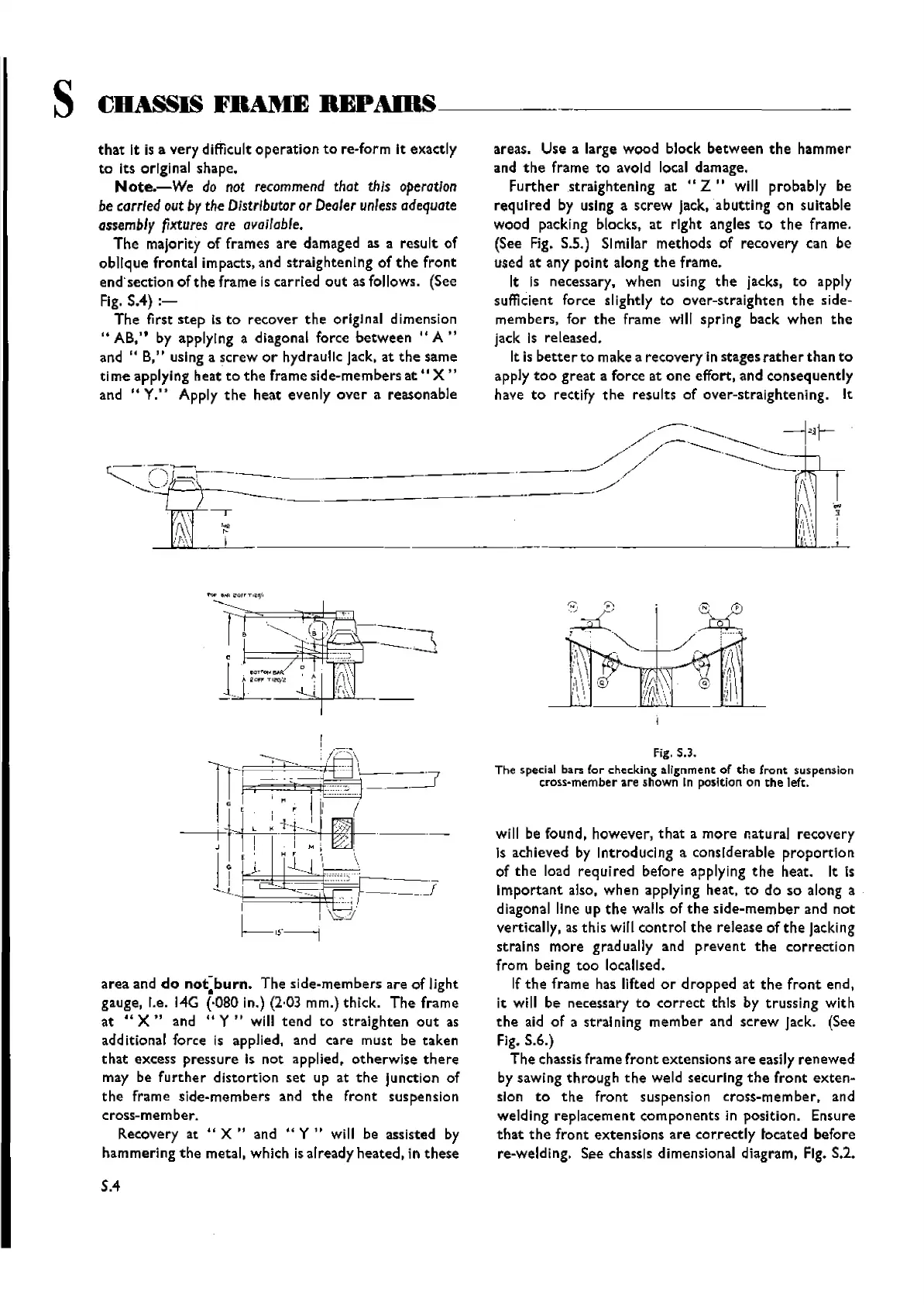S CHASSIS FRAME
REPAIBS--~~
that
It is a very difficult
operation
to
re-form It exactly
to
Its original shape.
Note.-We
do not
recommend
that this
operation
becarriedout bythe DistrIbutoror Dealer
unless
adequate
assembly
fixtures
are available.
The
majority of frames
are
damaged as a
result
of
oblique
frontal impacts, and straightening of
the
front
and'section of
the
frame is carried
out
as follows. (See
Fig.
5.4):-
The
first
step
Is
to
recover
the
origInal dimension
.. AB," by applying a diagonal force
between"
A "
and"
B,"
using a
screw
or
hydraulic Jack, at
the
same
time
applying heat
to
the
frame side-members
at"
X"
and
"Y."
Apply
the
heat
evenly
over
a reasonable
area
and
do
not:burn. The
side-members
are
of light
gauge, I.e. 14G (·080 in.) (2·03 mm.) thick.
The
frame
at ..
X"
and
"Y"
will
tend
to
straighten
out
as
additional force is applied, and
care
must be taken
that
excess
pressure
is
not
applied.
otherwise
there
may be
further
distortion
set
up at
the
Junction of
the
frame
side-members
and
the
front
suspension
cross-member.
Recovery at
"X
" and
"Y"
will be assisted by
hammering
the
metal, which isalready
heated,
in
these
SA
areas. Use a large
wood
block
between
the
hammer
and
the
frame
to
avoid local damage.
Further
straightening at
"Z
II
will probably be
requlred by using a
screw
jack.
abutting
on suitable
wood
packing blocks. at right angles
to
the
frame.
(See Fig. 5.5.) Similar methods of recovery can be
used at any
point
along
the
frame.
It Is necessary.
when
using
the
jacks,
to
apply
sufficient force
slightly
to
over-straighten
the
side-
members, for
the
frame will spring back
when
the
jack is released.
It is
bette
r
to
make a recovery In stages
rathe
r
than
to
apply
too
great
a force at
one
effort, and consequently
have
to
rectify
the
results of
over-straightening.
It
I
_________
~
------''''''-'-L-....L-
fig. S.3.
The special bars
for
checking
alignment
of
the
front
suspension
cress-member are
shown
In
position
on the left.
will be found,
however,
that
a
more
natural
recovery
is achieved by Introducing a considerable
proportion
of
the
load
required
before applying
the
heat. It Is
Important
also.
when
applying heat.
to
do so along a
diagonal line up
the
walls of
the
side-member
and
not
vertically, as
this
will
control
the
release of
the
Jacking
strains
more
gradually and
prevent
the
correction
from
being
too
localised.
If
the
frame has lifted
or
dropped
at
the
front
end,
it will be necessary
to
correct
this
by
trussing
with
the
aid of a straining
member
and
screw
Jack. (See
Fig. S.6.)
The
chassis frame
front
extensions
are
easily
renewed
by sawing
through
the
weld securing
the
front
exten-
slon
to
the
front
suspension
cross-member,
and
welding
replacement
components
in position. Ensure
that
the
front
extensions
are
correctly
tocated before
re-welding. See chassis dimensional diagram, Fig. 5.2.
Wishvilles Classic
Automobile Library
